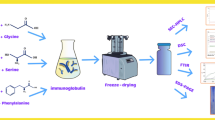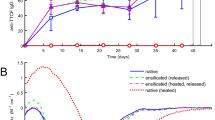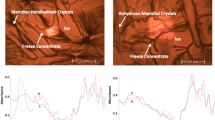ABSTRACT
Purpose
The study was carried out to evaluate the effect of exposing solid tetanus toxoid to moisture in two different ways on the structure and function of the toxoid.
Methods
Tetanus toxoid was exposed to moisture by (i) the addition of an optimized amount of buffer and (ii) incubation under an environment provided by a saturated solution of K2CrO4. The changes in the conformational, structural and antigenic properties of tetanus toxoid were measured and compared.
Results
Results show that even at a similar level of moisture-induced aggregation, the amounts of water absorbed by the two preparations of tetanus toxoid are different. Differences in antigenicity and changes in structure of the toxoid at primary, secondary and tertiary structure levels were seen.
Conclusion
Although both conditions are used to mimic accelerated stability conditions in the laboratory, the final products are different in the two cases. Thus, conditions for ‘accelerated stability studies’ for therapeutic proteins need to be selected with care so that they resemble the fate of the actual product.






Similar content being viewed by others
REFERENCES
Quaak SG, Haanen JB, Beijnen JH, Nuijen B. Naked plasmid DNA formulation: effect of different disaccharides on stability after lyophilisation. AAPS PharmSciTech. 2010;11:344–50.
Costantino HR, Langer R, Klibanov AM. Solid-phase aggregation of proteins under pharmaceutically relevant conditions. J Pharm Sci. 1994;83:1662–9.
Chang LL, Pikal MJ. Mechanisms of protein stabilization in the solid state. J Pharm Sci. 2009;98:2886–908.
Lai MC, Topp EM. Solid-state chemical stability of proteins and peptides. J Pharm Sci. 1999;88:489–500.
Jain NK, Roy I. Trehalose and protein stability. Curr Protoc Protein Sci. Chapter 4:Unit 4.9; 2010.
Jain NK, Roy I. Role of trehalose in moisture-induced aggregation of bovine serum albumin. Eur J Pharm Biopharm. 2008;69:824–34.
Jain NK, Roy I. Effect of trehalose on protein structure. Protein Sci. 2009;18:24–36.
Wang W, Nema S, Teagarden D. Protein aggregation-pathways and influencing factors. Int J Pharm. 2010;390:89–99.
Chang AC, Gupta RK. Stabilization of tetanus toxoid in poly(DL-lactic-co-glycolic acid) microspheres for the controlled release of antigen. J Pharm Sci. 1996;85:129–32.
Costantino HR, Langer R, Klibanov AM. Moisture-induced aggregation of lyophilized insulin. Pharm Res. 1994;11:21–9.
Costantino HR, Langer R, Klibanov AM. Aggregation of a lyophilized pharmaceutical protein, recombinant human albumin: effect of moisture and stabilization by excipients. Biotechnology (NY). 1995;13:493–6.
Liu WR, Langer R, Klibanov AM. Moisture-induced aggregation of lyophilized proteins in the solid state. Biotechnol Bioeng. 1991;37:177–84.
Zhou P, Liu X, Labuza TP. Effects of moisture-induced whey protein aggregation on protein conformation, the state of water molecules, and the microstructure and texture of high-protein-containing matrix. J Agric Food Chem. 2008;56:4534–40.
Jiang W, Schwendeman SP. Formaldehyde-mediated aggregation of protein antigens: comparison of untreated and formalinized model antigens. Biotechnol Bioeng. 2000;70:507–17.
Zhou P, Liu X, Labuza TP. Moisture-induced aggregation of whey proteins in a protein/buffer model system. J Agric Food Chem. 2008;56:2048–54.
Schwendeman SP, Costantino HR, Gupta RK, Siber GR, Klibanov AM, Langer R. Stabilization of tetanus and diphtheria toxoids against moisture-induced aggregation. Proc Natl Acad Sci USA. 1995;92:11234–8.
Flores-Fernandez GM, Sola RJ, Griebenow K. The relation between moisture-induced aggregation and structural changes in lyophilized insulin. J Pharm Pharmacol. 2009;61:1555–61.
Bradford MM. A rapid and sensitive method for the quantitation of microgram quantities of protein utilizing the principle of protein-dye binding. Anal Biochem. 1976;72:248–54.
Laemmli UK. Cleavage of structural proteins during the assembly of the head of bacteriophage T4. Nature. 1970;227:680–5.
Determan AS, Wilson JH, Kipper MJ, Wannemuehler MJ, Narasimhan B. Protein stability in the presence of polymer degradation products: consequences for controlled release formulations. Biomaterials. 2006;27:3312–20.
Habeeb AF. Determination of free amino groups in proteins by trinitrobenzenesulfonic acid. Anal Biochem. 1966;14:328–36.
Ellman GL. Tissue sulfhydryl groups. Arch Biochem Biophys. 1959;82:70–7.
Riddles PW, Blakeley RL, Zerner B. Reassessment of Ellman’s reagent. Methods Enzymol. 1983;91:49–60.
Perez-Iratxeta C, Andrade-Navarro MA. K2D2: estimation of protein secondary structure from circular dichroism spectra. BMC Struct Biol. 2008;8:25.
Nilsson MR. Techniques to study amyloid fibril formation in vitro. Methods (San Diego, Calif). 2004;34:151–60.
Sanchez A, Villamayor B, Guo Y, McIver J, Alonso MJ. Formulation strategies for the stabilization of tetanus toxoid in poly(lactide-co-glycolide) microspheres. Int J Pharm. 1999;185:255–66.
Jiang W, Schwendeman SP. Stabilization of tetanus toxoid encapsulated in PLGA microspheres. Mol Pharmaceutics. 2008;5:808–17.
Hageman MJ. The role of moisture in protein stability. Drug Dev Indus Pharm. 1988;14:2047–70.
Separovic F, Lam YH, Ke X, Chan H-K. A solid-state NMR study of protein hydration and stability. Pharm Res. 1998;15:1816–21.
Smith AL, Shirazi HM, Mulligan SR. Water sorption isotherms and enthalpies of water sorption by lysozyme using the quartz crystal microbalance/heat conduction calorimeter. Biochim Biophys Acta. 2002;1594:150–9.
Bone S. Dielectric and gravimetric studies of water binding to lysozyme. Phys Med Biol. 1996;41:1265–75.
D’Arcy RL, Watt IC. Analysis of sorption isotherms of nonhomogeneous sorbents. Trans Faraday Soc. 1970;66:1236–45.
Luscher-Mattli M. Thermodynamic parameters of biopolymer-water systems. In: Hinz H-J, editor. Thermodynamic data for biochemistry and biotechnology. Berlin: Springer-Verlag; 1986. p. 276–94.
Aggerbeck H, Heron I. Detoxification of diphtheria and tetanus toxin with formaldehyde. Detection of protein conjugates. Biologicals. 1992;20:109–15.
Robinson JP, Picklesimer JB, Puett D. Tetanus toxin. The effect of chemical modifications on toxicity, immunogenicity, and conformation. J Biol Chem. 1975;250:7435–42.
Pedersen JS, Otzen DE. Amyloid-a state in many guises: survival of the fittest fibril fold. Protein Sci. 2008;17:2–10.
Kumar S, Udgaonkar JB. Structurally distinct amyloid protofibrils form on separate pathways of aggregation of a small protein. Biochemistry. 2009;48:6441–9.
Kumar S, Udgaonkar JB. Conformational conversion may precede or follow aggregate elongation on alternative pathways of amyloid protofibril formation. J Mol Biol. 2009;385:1266–76.
Johansen P, Merkle HP, Gander B. Physico-chemical and antigenic properties of tetanus and diphtheria toxoids and steps towards improved stability. Biochim Biophys Acta. 1998;1425:425–36.
ACKNOWLEDGMENTS
Partial financial support received from Department of Biotechnology (Gov’t of India) is gratefully acknowledged. NKJ acknowledges the grant of senior research fellowship from Council for Scientific and Industrial Research (Gov’t of India). The authors thank Mr. Dinesh Kumar for recording the scanning electron micrographs.
Author information
Authors and Affiliations
Corresponding author
Rights and permissions
About this article
Cite this article
Jain, N.K., Roy, I. Accelerated Stability Studies for Moisture-Induced Aggregation of Tetanus Toxoid. Pharm Res 28, 626–639 (2011). https://doi.org/10.1007/s11095-010-0316-2
Received:
Accepted:
Published:
Issue Date:
DOI: https://doi.org/10.1007/s11095-010-0316-2




